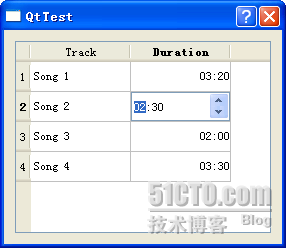自定义委托
来源:互联网 发布:淘宝店铺标志怎么没了 编辑:程序博客网 时间:2024/04/29 17:19
还是继续前面的内容。前面我们分三次把自定义model说完了,其实主要还是那三个实例。在 model/view 架构中,与model同等重要的就是 view。
我们知道,在经典的 MVC 模型中,view用于向用户展示 model 的数据。但是,Qt提供的不是 MVC 三层架构,而是一个 model/view 设计。这种设计并没有包含一个完整而独立的组件用于管理用户的交互。一般来说,view仅仅是用作对model数据的展示和对用户输入的处理,而不应该去做其他的工作。在这种结构中,为了获得对用户输入控制的灵活性,这种交互工作交给了delegate,也就是“委托”,去完成。简单来说,就像它们的名字一样,view 将用户输入委托给 delegate 处理,而自己不去处理这种输入。这些组件提供一种输入能力,并且能够在某些 view 中提供这种交互情形下的渲染,比如在 table 中通过双击单元格即可编辑内容等。对这种控制委托的标准接口被定义在 QAbstractItemDelegate 类中。
delegate 可以用于渲染内容,这是通过 paint() 和 sizeHint() 函数来完成的。但是,对于一些简单的基于组件的delegate,可以通过继承 QItemDelegate 或者 QStyledItemDelegate 来实现。这样就可以避免要完全重写 QAbstractItemDelegate 中所需要的所有函数。对于一些相对比较通用的函数,在这两个类中已经有了一个默认的实现。
Qt提供的标准组件使用 QItemDelegate 提供编辑功能的支持。这种默认的实现被用在 QListView,QTableView 和 QTreeView 之中。view 实用的delegate可以通过 itemDelegate() 函数获得。setItemDelegate() 函数则可以为一个标准组件设置自定义的 delegate。
Qt 4.4版本之后提供了两个可以被继承的delegate类:QItemDelegate 和 QStyledItemDelegate。默认的delegate是 QStyledItemDelegate。这两个类可以被相互替代,用于给view 组件提供绘制和编辑的功能。它们之间的主要区别在于,QStyledItemDelegate 使用当前的风格(style)去绘制组件。所以,在自定义delegate或者需要使用 Qt style sheets 时,建议使用 QStyledItemDelegate 作为父类。使用这两个类的代码通常是一样的,除了需要使用style进行绘制的部份。如果你希望为view item自定义绘制函数,最好实现一个自定义的style。这个你可以通过QStyle类来实现。
如果delegate没有支持为你的数据类型进行绘制,或者你希望自己绘制item,那么就可以继承 QStyledItemDelegate 类,并且重写 paint() 或者还需要重写 sizeHint() 函数。paint() 函数会被每一个item独立调用,而sizeHint()函数则可以定义每一个item 的大小。在重写 paint() 函数的时候,通常需要用 if 语句找到你需要进行渲染的数据类型并进行绘制,其他的数据类型需要调用父类的实现进行绘制。
一个自定义的delegate也可以直接提供一个编辑器,而不是使用内置的编辑器工厂(editor item factory)。如果你需要这种功能,那么需要实现一下几个函数:
- createEditor(): 返回修改数据的组件;
- setEditorData(): 为editor提供编辑的原始数据;
- updateEditorGeometry(): 保证editor显示在 item view 的合适位置以及大小;
- setModelData(): 根据editor 的数据更新model的数据。
好了,这就是一个自定义delegate的实现了。下面来看一个例子。
这是一个歌曲及其时间的例子。使用的是QTableWidget,一共有两列,第一列是歌曲名字,第二列是歌曲持续的时间。为了表示这个数据,我们建立一个Track类:
track.h
 #ifndef TRACK_H
#ifndef TRACK_H  #define TRACK_H
#define TRACK_H 
 #include <QtCore>
#include <QtCore> 
 class Track
class Track  {
{  public:
public:  Track(const QString &title = "", int duration = 0);
Track(const QString &title = "", int duration = 0); 
 QString title;
QString title;  int duration;
int duration;  };
}; 
 #endif // TRACK_H
#endif // TRACK_Htrack.cpp
 #include "track.h"
#include "track.h" 
 Track::Track(const QString &title, int duration)
Track::Track(const QString &title, int duration)  : title(title), duration(duration)
: title(title), duration(duration)  {
{  }
}这个类的构造函数没有做任何操作,只是把title和duration这两个参数通过构造函数初始化列表赋值给内部的成员变量。注意,现在这两个成员变量都是public的,在正式的程序中应该声明为private的才对。然后来看TrackDelegate类:
trackdelegate.h
 #ifndef TRACKDELEGATE_H
#ifndef TRACKDELEGATE_H  #define TRACKDELEGATE_H
#define TRACKDELEGATE_H 
 #include <QtGui>
#include <QtGui> 
 class TrackDelegate : public QStyledItemDelegate
class TrackDelegate : public QStyledItemDelegate  {
{  Q_OBJECT
Q_OBJECT 
 public:
public:  TrackDelegate(int durationColumn, QObject *parent = 0);
TrackDelegate(int durationColumn, QObject *parent = 0); 
 void paint(QPainter *painter, const QStyleOptionViewItem &option, const QModelIndex &index) const;
void paint(QPainter *painter, const QStyleOptionViewItem &option, const QModelIndex &index) const;  QWidget *createEditor(QWidget *parent, const QStyleOptionViewItem &option, const QModelIndex &index) const;
QWidget *createEditor(QWidget *parent, const QStyleOptionViewItem &option, const QModelIndex &index) const;  void setEditorData(QWidget *editor, const QModelIndex &index) const;
void setEditorData(QWidget *editor, const QModelIndex &index) const;  void setModelData(QWidget *editor, QAbstractItemModel *model, const QModelIndex &index) const;
void setModelData(QWidget *editor, QAbstractItemModel *model, const QModelIndex &index) const; 
 private slots:
private slots:  void commitAndCloseEditor();
void commitAndCloseEditor(); 
 private:
private:  int durationColumn;
int durationColumn;  };
}; 

 #endif // TRACKDELEGATE_H
#endif // TRACKDELEGATE_H trackdelegate.cpp
 #include "trackdelegate.h"
#include "trackdelegate.h" 
 TrackDelegate::TrackDelegate(int durationColumn, QObject *parent)
TrackDelegate::TrackDelegate(int durationColumn, QObject *parent)  : QStyledItemDelegate(parent)
: QStyledItemDelegate(parent)  {
{  this->durationColumn = durationColumn;
this->durationColumn = durationColumn;  }
} 
 void TrackDelegate::paint(QPainter *painter, const QStyleOptionViewItem &option, const QModelIndex &index) const
void TrackDelegate::paint(QPainter *painter, const QStyleOptionViewItem &option, const QModelIndex &index) const  {
{  if (index.column() == durationColumn) {
if (index.column() == durationColumn) {  int secs = index.model()->data(index, Qt::DisplayRole).toInt();
int secs = index.model()->data(index, Qt::DisplayRole).toInt();  QString text = QString("%1:%2").arg(secs / 60, 2, 10, QChar('0')).arg(secs % 60, 2, 10, QChar('0'));
QString text = QString("%1:%2").arg(secs / 60, 2, 10, QChar('0')).arg(secs % 60, 2, 10, QChar('0'));  QTextOption o(Qt::AlignRight | Qt::AlignVCenter);
QTextOption o(Qt::AlignRight | Qt::AlignVCenter);  painter->drawText(option.rect, text, o);
painter->drawText(option.rect, text, o);  } else {
} else {  QStyledItemDelegate::paint(painter, option, index);
QStyledItemDelegate::paint(painter, option, index);  }
}  }
} 
 QWidget *TrackDelegate::createEditor(QWidget *parent, const QStyleOptionViewItem &option, const QModelIndex &index) const
QWidget *TrackDelegate::createEditor(QWidget *parent, const QStyleOptionViewItem &option, const QModelIndex &index) const  {
{  if (index.column() == durationColumn) {
if (index.column() == durationColumn) {  QTimeEdit *timeEdit = new QTimeEdit(parent);
QTimeEdit *timeEdit = new QTimeEdit(parent);  timeEdit->setDisplayFormat("mm:ss");
timeEdit->setDisplayFormat("mm:ss");  connect(timeEdit, SIGNAL(editingFinished()), this, SLOT(commitAndCloseEditor()));
connect(timeEdit, SIGNAL(editingFinished()), this, SLOT(commitAndCloseEditor()));  return timeEdit;
return timeEdit;  } else {
} else {  return QStyledItemDelegate::createEditor(parent, option, index);
return QStyledItemDelegate::createEditor(parent, option, index);  }
}  }
} 
 void TrackDelegate::commitAndCloseEditor()
void TrackDelegate::commitAndCloseEditor()  {
{  QTimeEdit *editor = qobject_cast<QTimeEdit *>(sender());
QTimeEdit *editor = qobject_cast<QTimeEdit *>(sender());  emit commitData(editor);
emit commitData(editor);  emit closeEditor(editor);
emit closeEditor(editor);  }
} 
 void TrackDelegate::setEditorData(QWidget *editor, const QModelIndex &index) const
void TrackDelegate::setEditorData(QWidget *editor, const QModelIndex &index) const  {
{  if (index.column() == durationColumn) {
if (index.column() == durationColumn) {  int secs = index.model()->data(index, Qt::DisplayRole).toInt();
int secs = index.model()->data(index, Qt::DisplayRole).toInt();  QTimeEdit *timeEdit = qobject_cast<QTimeEdit *>(editor);
QTimeEdit *timeEdit = qobject_cast<QTimeEdit *>(editor);  timeEdit->setTime(QTime(0, secs / 60, secs % 60));
timeEdit->setTime(QTime(0, secs / 60, secs % 60));  } else {
} else {  QStyledItemDelegate::setEditorData(editor, index);
QStyledItemDelegate::setEditorData(editor, index);  }
}  }
} 
 void TrackDelegate::setModelData(QWidget *editor, QAbstractItemModel *model, const QModelIndex &index) const
void TrackDelegate::setModelData(QWidget *editor, QAbstractItemModel *model, const QModelIndex &index) const  {
{  if (index.column() == durationColumn) {
if (index.column() == durationColumn) {  QTimeEdit *timeEdit = qobject_cast<QTimeEdit *>(editor);
QTimeEdit *timeEdit = qobject_cast<QTimeEdit *>(editor);  QTime time = timeEdit->time();
QTime time = timeEdit->time();  int secs = (time.minute() * 60) + time.second();
int secs = (time.minute() * 60) + time.second();  model->setData(index, secs);
model->setData(index, secs);  } else {
} else {  QStyledItemDelegate::setModelData(editor, model, index);
QStyledItemDelegate::setModelData(editor, model, index);  }
}  }
} 正如前面所说的,这个类继承了QStyledItemDelegate,覆盖了其中的四个函数。通过前面的讲解,我们已经了解到这些函数的作用。至于实现,我们前面也说过,需要通过QModelIndex选择我们需要进行渲染的列,然后剩下的数据类型仍然需要显式地调用父类的相应函数。由于我们在Track里面存储的是歌曲的秒数,所以在paint()里面需要用除法计算出分钟数,用%60计算秒数。其他的函数都比较清楚,请注意代码。
最后写一个使用的类:
trackeditor.h
 #ifndef TRACKEDITOR_H
#ifndef TRACKEDITOR_H  #define TRACKEDITOR_H
#define TRACKEDITOR_H 
 #include <QtGui>
#include <QtGui>  #include "track.h"
#include "track.h" 
 class TrackEditor : public QDialog
class TrackEditor : public QDialog  {
{  Q_OBJECT
Q_OBJECT 
 public:
public:  TrackEditor(QList<Track> *tracks, QWidget *parent);
TrackEditor(QList<Track> *tracks, QWidget *parent); 
 private:
private:  QList<Track> *tracks;
QList<Track> *tracks;  QTableWidget *tableWidget;
QTableWidget *tableWidget;  };
}; 
 #endif // TRACKEDITOR_H
#endif // TRACKEDITOR_Htrackeditor.cpp
 #include "trackeditor.h"
#include "trackeditor.h"  #include "trackdelegate.h"
#include "trackdelegate.h" 
 TrackEditor::TrackEditor(QList<Track> *tracks, QWidget *parent)
TrackEditor::TrackEditor(QList<Track> *tracks, QWidget *parent)  : QDialog(parent)
: QDialog(parent)  {
{  this->tracks = tracks;
this->tracks = tracks; 
 tableWidget = new QTableWidget(tracks->count(), 2);
tableWidget = new QTableWidget(tracks->count(), 2);  tableWidget->setItemDelegate(new TrackDelegate(1));
tableWidget->setItemDelegate(new TrackDelegate(1));  tableWidget->setHorizontalHeaderLabels(QStringList() << tr("Track") << tr("Duration"));
tableWidget->setHorizontalHeaderLabels(QStringList() << tr("Track") << tr("Duration")); 
 for (int row = 0; row < tracks->count(); ++row) {
for (int row = 0; row < tracks->count(); ++row) {  Track track = tracks->at(row);
Track track = tracks->at(row); 
 QTableWidgetItem *item0 = new QTableWidgetItem(track.title);
QTableWidgetItem *item0 = new QTableWidgetItem(track.title);  tableWidget->setItem(row, 0, item0);
tableWidget->setItem(row, 0, item0); 
 QTableWidgetItem *item1 = new QTableWidgetItem(QString::number(track.duration));
QTableWidgetItem *item1 = new QTableWidgetItem(QString::number(track.duration));  item1->setTextAlignment(Qt::AlignRight);
item1->setTextAlignment(Qt::AlignRight);  tableWidget->setItem(row, 1, item1);
tableWidget->setItem(row, 1, item1);  }
} 
 QVBoxLayout *mainLayout = new QVBoxLayout;
QVBoxLayout *mainLayout = new QVBoxLayout;  mainLayout->addWidget(tableWidget);
mainLayout->addWidget(tableWidget);  this->setLayout(mainLayout);
this->setLayout(mainLayout);  }
} 其实也并没有很大的不同,只是我们使用setItemDelegate()函数设置了一下delegate。然后写main()函数:
 #include <QtGui>
#include <QtGui>  #include "trackeditor.h"
#include "trackeditor.h" 
 int main(int argc, char *argv[])
int main(int argc, char *argv[])  {
{  QApplication a(argc, argv);
QApplication a(argc, argv);  QList<Track> tracks;
QList<Track> tracks;  Track t1("Song 1", 200);
Track t1("Song 1", 200);  Track t2("Song 2", 150);
Track t2("Song 2", 150);  Track t3("Song 3", 120);
Track t3("Song 3", 120);  Track t4("Song 4", 210);
Track t4("Song 4", 210);  tracks << t1 << t2 << t3 << t4;
tracks << t1 << t2 << t3 << t4;  TrackEditor te(&tracks, NULL);
TrackEditor te(&tracks, NULL);  te.show();
te.show();  return a.exec();
return a.exec();  }
} 好了,运行一下看看效果吧!

0 0
- 自定义委托
- EventHandler委托与自定义委托
- 自定义委托--48
- C#委托、自定义、事件
- 自定义事件和委托
- 自定义的委托 事件
- 利用委托自定义事件
- 利用委托自定义事件
- QT 自定义委托
- QtCreator委托类 QItemDelegate,自定义委托类
- QtCreator委托类 QItemDelegate,自定义委托类
- c# 自定义事件和委托
- C#委托、自定义事件详解
- 自定义协议或实现委托
- c# 自定义事件和委托
- C# 自定义事件和委托
- c# 自定义事件和委托
- c# 自定义事件和委托
- 重构
- version `GFORTRAN_1.4' not found (required by /usr/lib/liblapack.so.3) 问题的解决方案
- ionic提示/usr/bin/env: node: 没有那个文件或目录
- 华为机试---计算日期到天数转换
- redis集群扩容
- 自定义委托
- Jira和Confluence集成Crowd实现SSO-构建高效的团队协作工具
- Python 运算符
- Cloudera升级☞第一篇Cloudera Manager升级
- svg 二次曲线
- 第一次去面试
- leetcode Remove Duplicates from Sorted List II
- 如何在googleplay上发布应用?
- java企业级应用之术语篇


